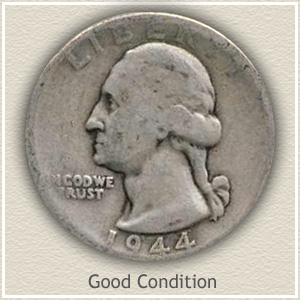1944 Quarter Value

Washington Quarter Dollar

By George! A coin for all seasons By Paul Gilkes
COIN WORLD Staff The Washington quarter dollar was born out of the Treasury Department's desire to produce a coin to mark the bicentennial of the birth of the first presid...READ MORE
Washington Quarter Dollar
By George! A coin for all seasons1944 Washington Quarter Value
By Paul Gilkes
In this video I provide a brief overview of the value of a Washington silver quarter. I also list the few key (rare, valuable) dates that exist and provide t. Washington Quarter, 1944-S MS Auction Record: $18,400.00. ANACS MS63. Heritage Auctions Filter Results. 1944-S Washington Quarter Value in mint state is worth $10 and up retail but it must be in a PCGS, NGC, ANACS or ICG holder. A raw or ungraded uncirculated example will sell for less. If a 1944-S Washington Quarter Value looks like the G4 coin below it’s worth $3 to $5 retail. Cleaned or damaged coins trade for less.

COIN WORLD Staff The Washington quarter dollar was born out of the Treasury Department's desire to produce a coin to mark the bicentennial of the birth of the first president of the United States. Coinage presses had remained dormant for more than a year after production of Standing Liberty quarter dollars had ceased in 1930. Standing Liberty quarter dollars had only lasted for 14 years, not the 25 that the Mint Act of Sept. 26, 1890, afforded the secretary of the Treasury without needing special legislation. Special legislation was needed to introduce the Washington coin. The bust originally was going to appear on a half dollar as proposed, but the bill was changed to reflect the use of the 25-cent denomination. Congress authorized the Washington quarter dollar on March 4, 1931. A design competition was staged with the mandate that the obverse had to be based on a bust of Washington sculptured into clay form in 1785 by Jean Antoine Houdon. The reverse had to depict a national symbol, such as a shield or eagle. The designs submitted by Laura Gardin Fraser – designer of the Oregon Trail commemorative half dollar and wife of Indian Head 5-cent coin designer James Earle Fraser – were declared the competition winners. Although the Fraser designs were overwhelmingly recommended by the Commission of Fine Arts and the Washington Bicentennial Commission, Secretary of the Treasury Andrew W. Mellon rejected them. Mellon favored another design from the more than 100 models that were submitted. Still, the commission pressed on with its selection of the Fraser models. The commission at one point had considered a suggestion that the eagle from the reverse of the Saint-Gaudens double eagle be replicated for the Washington quarter reverse, but the idea was scrapped as too provocative. Mellon left office in early March 1932, with unsuccessful pressure put on Mellon's successor, Ogden Mills of New York, who also rejected Fraser's designs after carefully reviewing the issue. In an April 16 letter to the Commission of Fine Arts, Mills made known his selection of the designs of sculptor John Flanagan. The approved models used from 1932 through the beginning of 1934 proved unsatisfactory in that the motto IN GOD WE TRUST was all but illegible and there was weakness in Washington's hair. Subsequently, the obverse hub has been modified numerous times over the years to sharpen details. The reverse hubs have also been modified over the years with minor changes in details, mainly the leaves and lettering. To celebrate the nation's Bicentennial, the reverses of the quarter dollar, as well as Kennedy half dollar and Eisenhower dollar, were changed for the dual-dated coins (1776-1976). The eagle on the reverse was replaced with Jack L. Ahr's Colonial drummer design, with 13 stars surrounding a flame. The Bicentennial coins were struck in copper-nickel clad for circulation and silver clad for Proofs and special sets. The key dates to the Washington series through 2008 are both from the first year of issue – the 1932-D and 1932-S coins. They are the only two coins in the series with mintages under 1.6 million, with 436,800 and 408,000 coins respectively.
Washington, Eagle reverse | |
| Dates of authorization: | April 2, 1792; July 23, 1965; Oct. 18, 1973 |
| Dates of issue: | 1932-1998 |
| Designers: | John Flanagan (Bicentennial reverse): Jack L. Ahr |
| Engravers: | (Original obverse, reverse): John R. Sinnock (Bicentennial reverse): Frank Gasparro |
| Diameter: | 24.26 mm/0.96 inch |
| Weight: | (1932-1964, 1992-present silver Proofs only): 6.25 grams/0.20 ounce (1965-present): 5.67 grams/0.18 ounce (1976 Bicentennial Proof and Uncirculated): 5.75 grams/0.18 ounce |
| Metallic content: | (1932-1964, 1992-1998 Proofs only): 90% silver, 10% copper (1976 Bicentennial Proof and Uncirculated sets only): 80% silver, 20% copper bonded to a core of 21.5% silver, 78.5% copper (1965-1998): 75% copper, 25% nickel clad to pure copper core |
| Weight of pure silver: | (1932-1964, 1992-1998 silver Proofs only): 5.63 grams/0.18 ounce (1976 Bicentennial Proof and Uncirculated sets only): 2.30 grams/0.07 ounce |
| Edge: | Reeded |
| Mint mark: | (1932-1964): Reverse below eagle (1968-1998): Obverse right of Washington's ponytail |